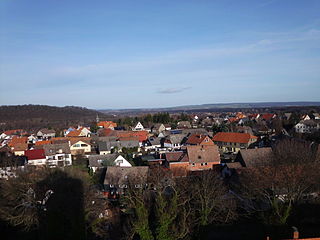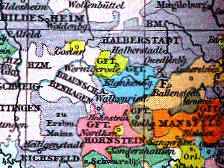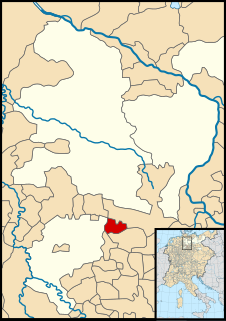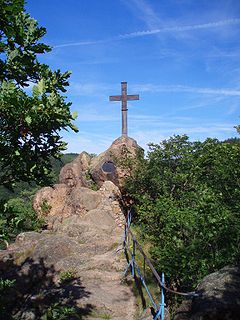History
A Saxon noble Alardus of Burgdorf is mentioned as a witness, when in 1218 Emperor Otto IV made his will at nearby Harzburg Castle. Alardus' ancestors had been vested with estates around the former Werla Kaiserpfalz in the 12th century and probably erected the castle where the Ecker River formed the border of the County of Wernigerode with the Principality of Brunswick-Wolfenbüttel.
Ahlsburg Castle itself was first mentioned as Alerdestein in a 1357 deed of donation, when Emperor Charles IV enfeoffed Alard the Elder and Alard the Younger of Burgdorf with 1 ½ hides at the village of Wollingerode (near Ilsenburg) that "belong to the Alerdestein". Like the Werla Kaiserpfalz, it then still was an immediate allod of the emperor, and the lords of the castle were responsible for protecting the game law in the surrounding Imperial forest.
In the early modern period, the castle fell into ruin. With the County of Wernigerode, ownership passed to the Counts of Stolberg (Stolberg-Wernigerode from 1645). After World War II, the Inner German Border passed through the birch pioneer forest. On a right-hand bend in the former Kolonnenweg, there is a signpost to, amongst other places, "Ahlsburg", which runs uphill from the Ecker for about 100 m (330 ft). Today, only a few vestiges of the Ahlsburg remain.

Wernigerode is a town in the district of Harz, Saxony-Anhalt, Germany. Until 2007, it was the capital of the district of Wernigerode. Its population was 35,041 in 2012.

The Oker is a river in Lower Saxony, Germany, that has historically formed an important political boundary. It is a left tributary of the River Aller, 128 kilometres (80 mi) in length and runs in a generally northerly direction.

The Harz is a highland area in northern Germany. It has the highest elevations for that region, and its rugged terrain extends across parts of Lower Saxony, Saxony-Anhalt, and Thuringia. The name Harz derives from the Middle High German word Hardt or Hart, Latinized as Hercynia. The Brocken is the highest summit in the Harz with an elevation of 1,141.1 metres (3,744 ft) above sea level. The Wurmberg is the highest peak located entirely within the state of Lower Saxony.

Goslar is a historic town in Lower Saxony, Germany. It is the administrative centre of the district of Goslar and located on the northwestern slopes of the Harz mountain range. The Old Town of Goslar and the Mines of Rammelsberg are UNESCO World Heritage Sites. Each year Goslar awards the Kaiserring to an international artist, called the "Nobel Prize" of the art world.

The Harzburg, also called Große Harzburg, is a former imperial castle, situated on the northwestern edge of the Harz mountain range overlooking the spa resort of Bad Harzburg in Goslar District in the state of Lower Saxony, Germany. It was erected from 1065 to 1068 at the behest of King Henry IV of Germany, slighted during the Saxon Rebellion in 1073-75, and a century later rebuilt under Emperor Frederick Barbarossa and his Welf successor Otto IV, who died here in 1218.

Ilsenburg is a town in the district of Harz, in Saxony-Anhalt in Germany. It is situated under the north foot of the Harz Mountains, at the entrance to the Ilse valley with its little river, the Ilse, a tributary of the Oker, about six 6 miles (9.7 km) north-west of the town of Wernigerode. It received town privileges in 1959. Owing to its surrounding of forests and mountains as well as its position on the edge of the Harz National Park, Ilsenburg is a popular tourist resort. Since 2002, it is officially an air spa.

Vienenburg is a borough of Goslar, capital of the Goslar district, in Lower Saxony, Germany. The former independent municipality was incorporated in Goslar on 1 January 2014.

Elbingerode (Harz) is an Ortsteil of Oberharz am Brocken in the Harz district, in the German state of Saxony-Anhalt. The former town was incorporated into the newly established municipality on 1 January 2010.

Derenburg is a town in the district of Harz, in Saxony-Anhalt, Germany. Since 1 January 2010, it has been part of the Blankenburg am Harz municipality.

Werlaburgdorf is a village and a former municipality in the district of Wolfenbüttel, Lower Saxony, Germany. Since 1 November 2013, it is part of the municipality Schladen-Werla.

Stapelburg is a village and a former municipality in the district of Harz, in Saxony-Anhalt, Germany. Since 1 January 2010, it is part of the Nordharz municipality.

The County of Blankenburg was a state of the Holy Roman Empire. Its capital was Blankenburg, it was located in and near the Harz mountains.

The County of Wernigerode was a state of the Holy Roman Empire which arose in the Harzgau region of the former Duchy of Saxony, at the northern foot of the Harz mountain range. The comital residence was at Wernigerode, now part of Saxony-Anhalt, Germany. The county was ruled by a branch of the House of Stolberg from 1429 until its mediatization to the Kingdom of Prussia in 1806. Nevertheless, the county remained in existence - with one short interruption - until the dissolution of the Kingdom of Prussia in 1918.

The Ecker is a 28-kilometre (17 mi), right-hand, southeast tributary of the Oker which runs mainly through the Harz mountains in the German states of Saxony-Anhalt and Lower Saxony.

The Stapelburg is a ruined mediæeval castle built to guard the road on the northern edge of the Harz mountains at Stapelburg in the district of Harz in the German state of Saxony-Anhalt.

Eckertal is a hamlet of about 160 inhabitants in Bad Harzburg in Lower Saxony, Germany.

The princes and counts of Stolberg are members of a large German dynasty of the former Holy Roman Empire's higher aristocracy. They played a significant role in feudal Germany's history and, as a mediatized dynasty, enjoyed princely privileges until the collapse of the German Empire in 1918. The house has numerous branches.

The Harly Forest is a hill range up to 256 m (840 ft) above NN in the district of Goslar in southeastern Lower Saxony, Germany.

The Ilsestein is a prominent granite rock formation near the town of Ilsenburg in the Harz mountains of central Germany. Offering a scenic view over the Ilse valley to the Brocken massif, the highest mountain of the range, it is today a popular tourist destination.

The Scharfenstein is a mountain, 697.6 m above sea level (NN) high, in the Harz Mountains of Germany, near Ilsenburg in the district of Harz in Saxony-Anhalt. It is part of the Harz National Park.





















